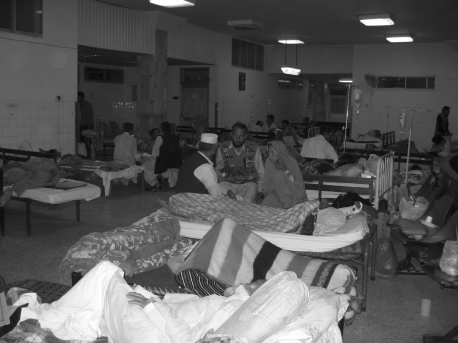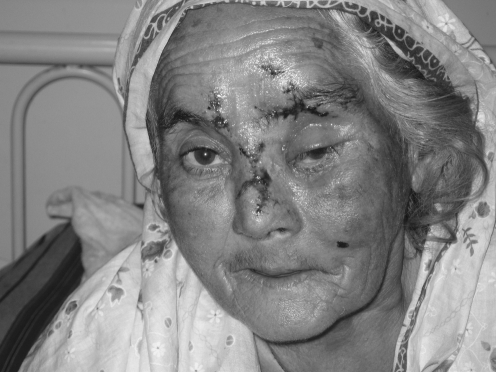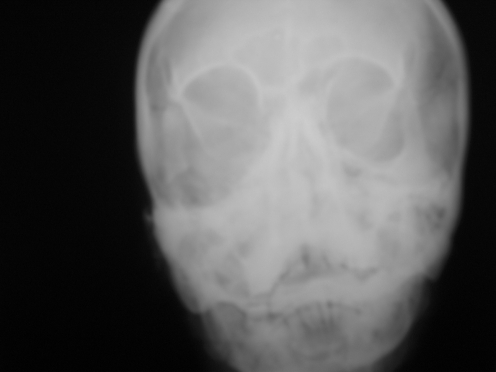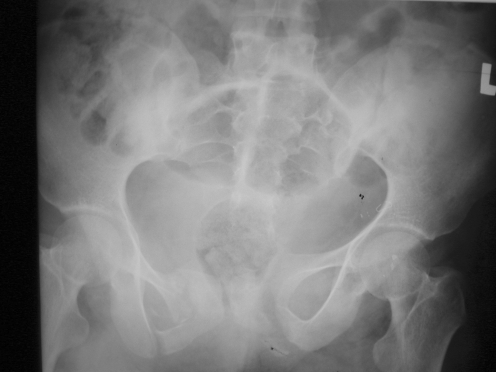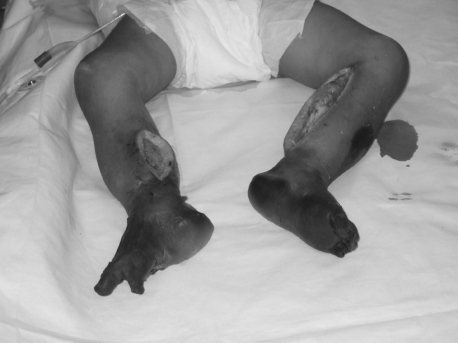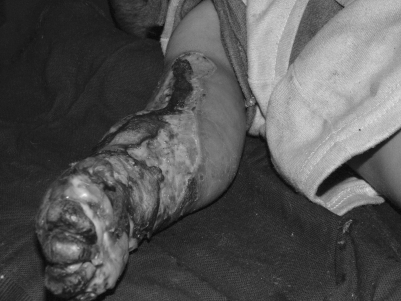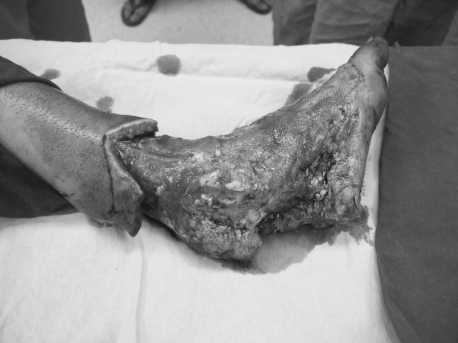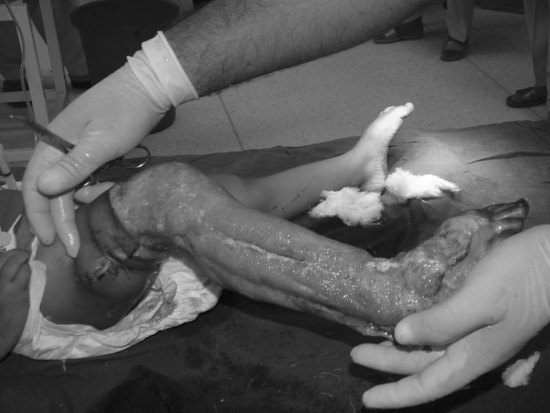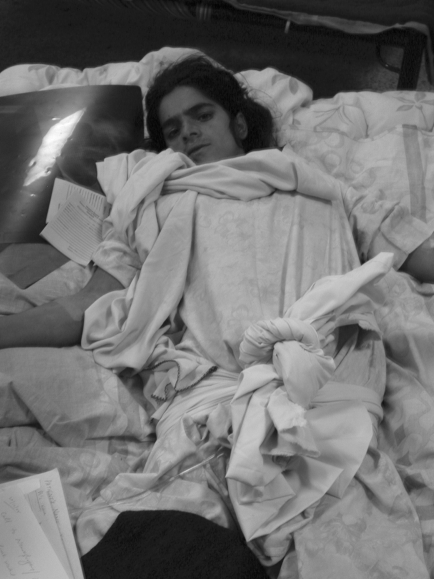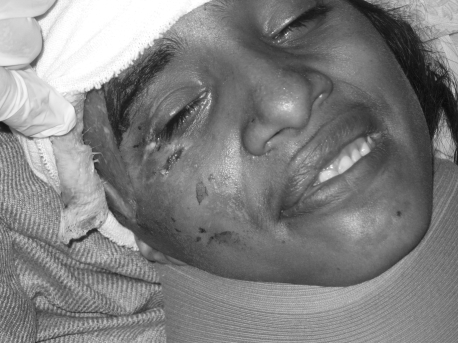Abstract
At 8:52 am on 8 October 2005 a massive earthquake wracked northern Pakistan and Kashmir. Various teams were sent to Islamabad and the disaster region from the UK. We discuss the types of injury patterns seen and recommend that a central register of volunteers should be created to deal with similar situations in the future.
At 8:52 am on 8 October 2005 a massive earthquake wracked northern Pakistan and Kashmir. News reports soon indicated that the numbers of dead (to date 80 000) and casualties were enormous and that the logistics of extricating such numbers from remote inaccessible regions would cause further difficulties. These desperate circumstances have been highlighted in a recent personal view from Richard Villar.1
A World Health Organization report warned that the number of casualties was overwhelming health teams on the ground, with more than 65 000 injured and 3.3 million homeless.2 The WHO report even suggested that the Kashmir crisis was a bigger disaster than the Asian tsunami.3
The absence of a central disaster volunteer register prompted an appeal on the BBC national news by the Association of Pakistani Physicians and Surgeons (APPS), which led to responses from a number of volunteer doctors and nurses. These were organised into various teams by the APPS and sent to Islamabad and the disaster region from the UK. Our team was the second APPS team to arrive from the UK, arriving 10 days after the earthquake. The first team consisting of junior doctors had been mobilised to work out in the field and was providing immediate first aid and stabilisation of injuries before evacuation. On arrival we were immediately assessed by the major incident coordinators within the Pakistani health service to have specialist hospital skills and to be of most use working within the large hospital complex of the Pakistan Institute of Medical Sciences (PIMS) in Islamabad. This hospital received many of the adult earthquake victims, with 2721 admissions from 4320 attendances, and also a lot of the injured children, 1449 admissions from 2477 attendances (fig 1, table 1).
Figure 1 The hospital foyer at the Pakistan Institute of Medical Sciences.
Table 1 Earthquake victims received and treated at the Pakistan Institute of Medical Sciences (PIMS) (as of June 2006).
| PIMS hospital | Total patients received | Total patients admitted | Operations | Deaths | |
|---|---|---|---|---|---|
| Major | Minor | ||||
| Adult hospital | 4320 | 2721 | 2390 | 2497 | 191† |
| Children's hospital | 2477 | 1449 | 1441 | 748 | 50 |
| Maternity hospital* | 362 | 55 | 01 | ||
| Total | 6797 | 4170 | 4199 | 3300 | |
*The maternity hospital also performed operations from the general adult and children's hospital.
†Includes 73 brought dead from the collapse of Margala Towers in Islamabad.
The efficient organisation by coordinators was commendable so that within a few hours of landing in Islamabad our team was operating and caring for the earthquake victims. Immediate impressions confirmed the reports that casualties had indeed overwhelmed the local facilities. Patients would arrive throughout the day by road transport and from late morning onwards helicopters would deliver patients from more remote regions. The 200 bedded children's hospital wards, seminar rooms, corridors and foyers were completely full and an endless list of young volunteers from the local community and universities helped the over burdened nurses and doctors to organise triage, referral and treatment. Although the situation seemed chaotic it soon became clear that there was a definite overriding control and casualties would gradually clear from the immediate triage centre, freeing space for further arrivals as the day progressed.
The requirement for the anaesthetists and theatre nurses was immediately obvious since a large number of surgical procedures in children were being done. The need for acute general surgical provision was less pressing since such patients had presumably succumbed to their various vascular or abdominal injuries and few patients were waiting with such needs. The general surgeons within our team adapted their skills accordingly and began dealing with the huge numbers of wound debridement and wound re‐suturing. A limited number of amputations had to be carried out. By the end of the week the hard work began to pay off and most wounds were ready for skin grafting. This was increasingly carried out as another general surgical colleague (AdS) joined our team. The success of effective work carried out by the team belies the importance of anaesthetic and nursing support within the team. Our members also worked effectively with professionals from various nationalities. We found that being a self‐contained team was greatly advantageous. Having access to an operating theatre (two tables) allowed us to provide help without depending on local resources. The presence of a theatre sister able to adapt to local circumstances greatly increased the coordination and throughput, thus maximising our efficiency.
The maxillofacial surgeon within the team (SL) had some reservations as to how useful his specialist surgical skills would be. In reality, however, vast numbers of patients suffered facial trauma (figs 2 and 3) and limited surgical equipment within the local facility meant that the specialist equipment brought with him was extremely useful. He and his radiology colleague (JR) placed themselves within the emergency department during the day where advanced trauma life support (ATLS) skills proved to very useful for triage and resuscitation. Although a basic triage had been performed in the field and although the delay to arrival meant that many seriously injured patients succumbed to their injuries before arrival, a lot of patients were seen that required immediate commencement of treatment. The presence of a radiologist was invaluable and all surgical specialties relied upon his expertise to a great extent. They then operated during the night, trying to choose specific cases that would benefit from specialised maxillofacial care.
Figure 2 Craniofacial injury affecting the frontal bone and left orbit.
Figure 3 Grossly displaced mid‐face trauma.
The complete range of traumatic injury was encountered, and those patients transferred to Islamabad tended to have poly‐trauma. Orthopaedic limb injuries were extremely common as were accompanying pelvic and spinal injuries, with 205 spinal injuries seen at PIMS in total (fig 4). Limb de‐gloving and crush injuries were again very common often with the associated sequelae of infection and gangrene (figs 5 and 6). The mechanism of de‐gloving injuries seemed to be of two types: firstly, through the patients being pulled out without the masonry being lifted off the limb; the other, more commonly, was from a relatively less severe crush where the bones and muscle survived but the skin and subcutaneous fat did not (figs 7 and 8). The children often presented with scalp lacerations and facial injuries, with many Le Fort mid‐face injuries seen, an uncommon injury in children in the UK. The injury pattern seen in adults differed with more back and spinal injuries, suggesting that their automatic reaction to falling masonary was to bend over but that the children, in their innocence, looked up.
Figure 4 Pelvic fractures.
Figure 5 Gangrene in a 2‐year‐old child necessitating amputation.
Figure 6 Gangrene in a young child.
Figure 7 Severe avulsion injury.
Figure 8 De‐gloving injury of the lower limb.
Improvised first aid techniques were used to provide traction (for example, house bricks hanging over the back of a chair to provide leg traction). Pelvic immobilisation (fig 9) or spinal control were utilised together with basic fluid resuscitation, particularly to avoid the renal complications of crush injuries.
Figure 9 Make‐shift pelvic splint.
Infection was common, both of open wounds and of a systemic nature. Old and active miliary tuberculosis was also seen on chest x ray, gas gangrene of extremities, and tetanus requiring ventilatory support was encountered. A total of 51 patients were admitted with tetanus and the serious nature of this disease and the limited amount of effective treatment resulted in 22 deaths (fig 10, table 2).
Figure 10 The risus sardonicus of tetanus.
Table 2 PIMS clinical activity for earthquake victims (as of February 2006 with 4057 admissions).
| Procedure | Total |
|---|---|
| Number of operations | 7499 |
| Plain x rays | 45351 |
| CT scans | 1392 |
| Ultrasounds | 2101 |
| Blood units issued | 4735 |
| Amputations | 150 |
| Paraplegia/spinal injuries | 205 |
| Tetanus patients | 51 |
| Died | 22 |
| Recovered/transferred | 29 |
| Number of deliveries in maternity hospital | 54 |
| Live births | 35 |
| IUD | 15 |
| Died after birth | 04 |
CT, computed tomography; IUD, intrauterine death.
There was no shortage of most medicines, fluids or blood, with 4735 units issued for transfusion. The orthopaedic teams were overwhelmed and there was a particular shortage of external fixators, limiting the success of other surgical techniques that had to be employed. The surgical skills required were those that needed a sound grounding in the basic principles of surgery in its most elemental form. The majority of problems were principally of wound management, proper suturing techniques and the ability to provide skin cover to extensive wounds. The pattern of treated injuries changed over the 3 week period. The initial debridement of wounds and fasciotomies gave way to amputation, then to stump formation and finally skin cover, with a combination of skin grafting and simple rotational flaps. Of all the earthquake victims received at PIMS, a total of 150 amputations were performed, affecting many children as well as adults.
The knowledge from the local health team was invaluable in best managing our combined resources. The situation demanded not only constant adaptability, but also the ability to “think outside the box”, as some of the surgical injuries were quite challenging. It is amazing what can be achieved with half a dozen of surgical instruments instead of the usual trays found in National Health Service hospitals. As a team we felt that the trip to Pakistan was very worthwhile and we all regretted that we could not donate further time and help.
While the organisational support provided by APPS was excellent, we would recommend that a regular central register of volunteers should be created to deal with similar situations in the future. This would allow doctors and nurses with sufficient experience to be mobilised in times of disaster and their hospital employers could be encouraged to assist with their very occasional absence from work. It would also seem sensible to have this organisation liaise with the country concerned and organise which specialties should be sent and the number of specialists required. The ad hoc basis of volunteer mobilisation, whilst laudable, leads to unnecessary delays and potentially a shortage of specific specialties and perhaps oversupply in others.
As a group we wish to commend the efforts of the Pakistani health workers and indeed the local population who provided wonderful care in a time of extreme pressure. We would surmise that in the future there may be considerable psychological consequences as well as continuing physical problems for those individuals affected by the earthquake. For the present the population has to rehabilitate the injured and the amputees. This will be difficult without a major increase in resources, including skilled clinicians and paramedical staff, as well as money.
Abbreviations
APPS - Association of Pakistani Physicians and Surgeons
ATLS - advanced trauma life support
PIMS - Pakistan Institute of Medical Sciences
WHO - World Health Organization
Footnotes
Competing interests: None declared.
Informed consent was obtained for publication of figs 1–10.
References
- 1.Villar R. Personal View: in Pakistan global relief has so far failed its test. BMJ 20053311151 [Google Scholar]
- 2.Barlow A. Appeal for doctors in earthquake zone. Hospital Doctor October 20053
- 3.Mozynski P. Kashmir crisis is worse than the Asian tsunami says WHO. BMJ 2005331926. [DOI] [PMC free article] [PubMed] [Google Scholar]



